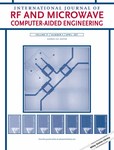An efficient tunable decoupling and matching method for simplifying compact dual-band mobile terminal antennas
Funding information: National Key R&D Program of China, Grant/Award Number: 2018YFB1802100; National Natural Science Foundation of China, Grant/Award Numbers: 61631012, 61801252, 61971250, U1809203; Natural Science Foundation of Ningbo, Grant/Award Numbers: 2019A610071, 202003N4108, 202003N4109; State Key Laboratory of Millimeter Waves, Grant/Award Number: K202014; Zhejiang Provincial Natural Science Foundation of China, Grant/Award Numbers: LQ21F010005, LY19F010004, LY21F010002
Abstract
An efficient tunable decoupling and matching method is proposed for simplifying compact mobile terminal antennas, that operates simultaneously in two independent bands. To enable carrier aggregation, the lower band in this design is tunable over the frequencies of interest for the traditional standards, while the upper band provides a fixed broad bandwidth to meet the bandwidth demands of 5G mobile terminal applications. Multi-element antenna systems, containing a simple antenna structure combined with tunable networks to realize dual-band decoupling and matching function, are systematically studied. The network structures are simplified to minimize the losses incurred in maintaining a good performance. To demonstrate the proposed approach, a two-element antenna system is developed in which the lower band can be tuned over the frequency range of 2.25 to 2.75 GHz, and the broad upper band can cover frequencies from 4.42 to 6.21 GHz. Good performance such as high total efficiency, low envelope correlation coefficient and stable radiation patterns, can be observed, thus, validating the effectiveness of the proposed method for simplifying the antenna structure.
Open Research
DATA AVAILABILITY STATEMENT
Data sharing is not applicable to this article as no new data were created or analyzed in this study.




